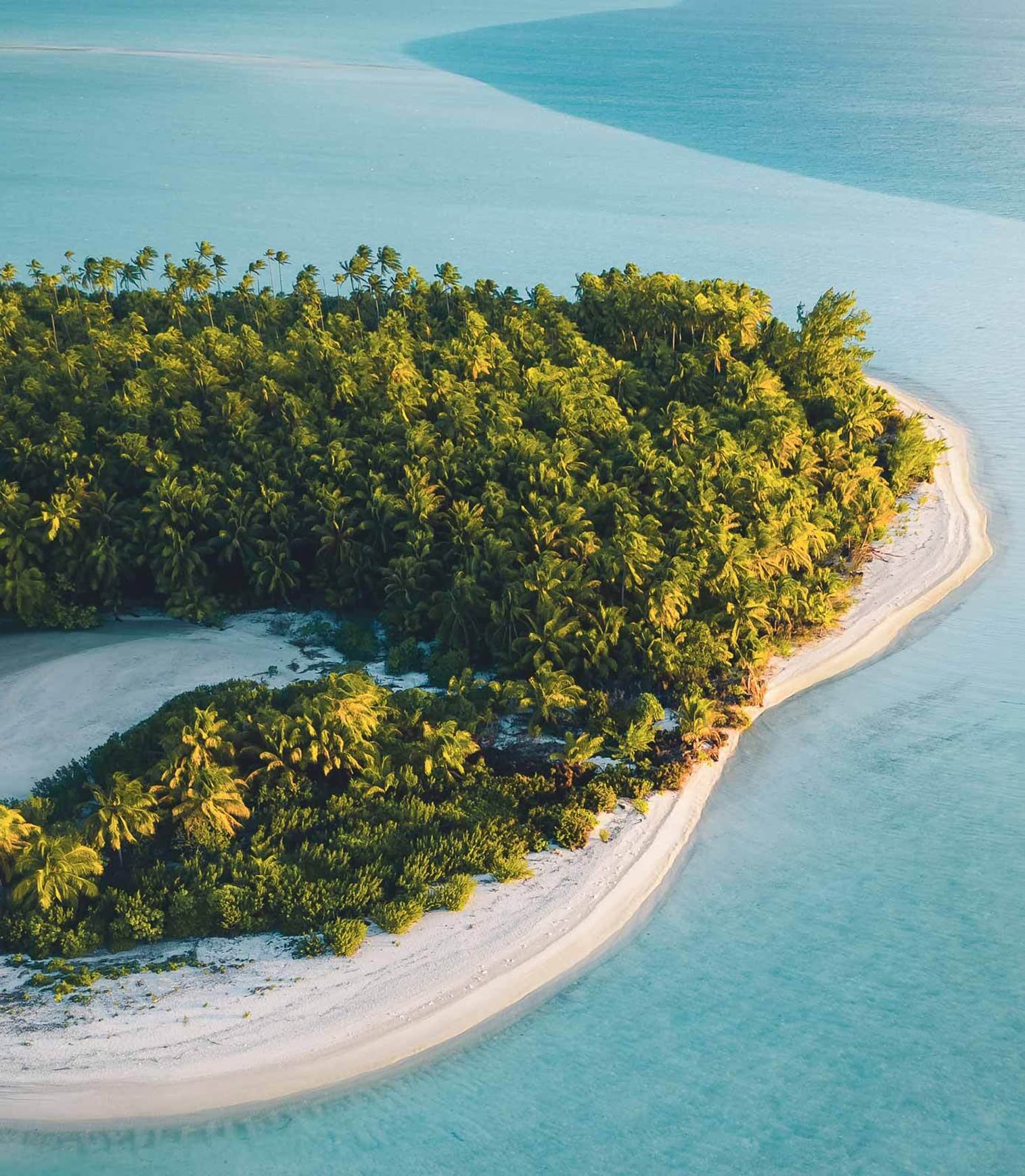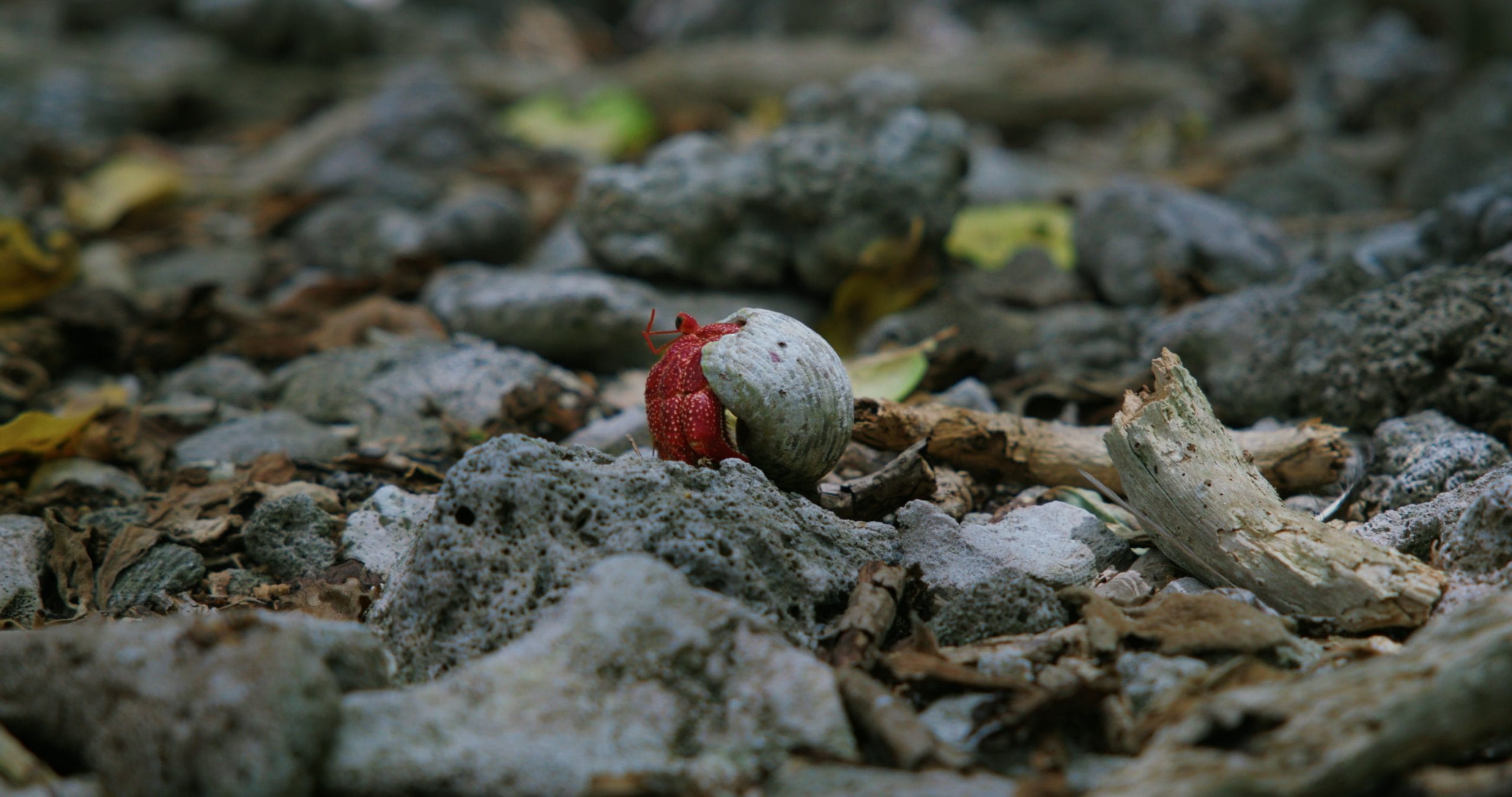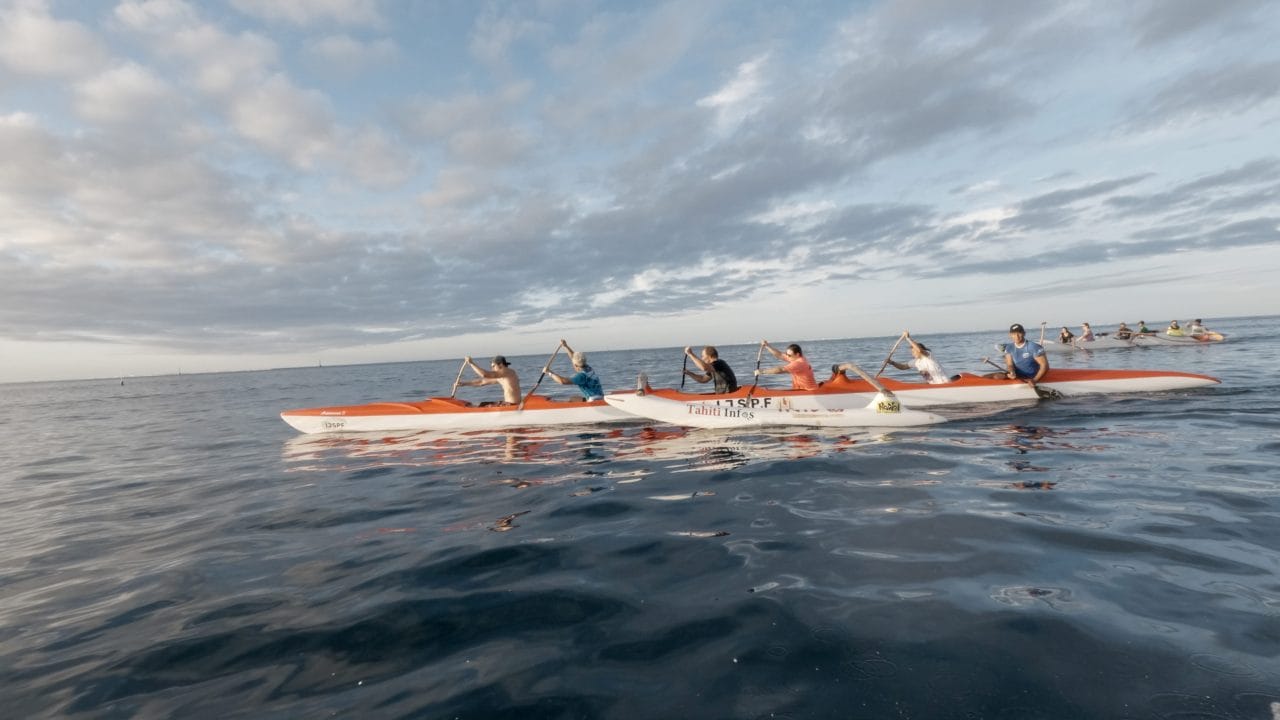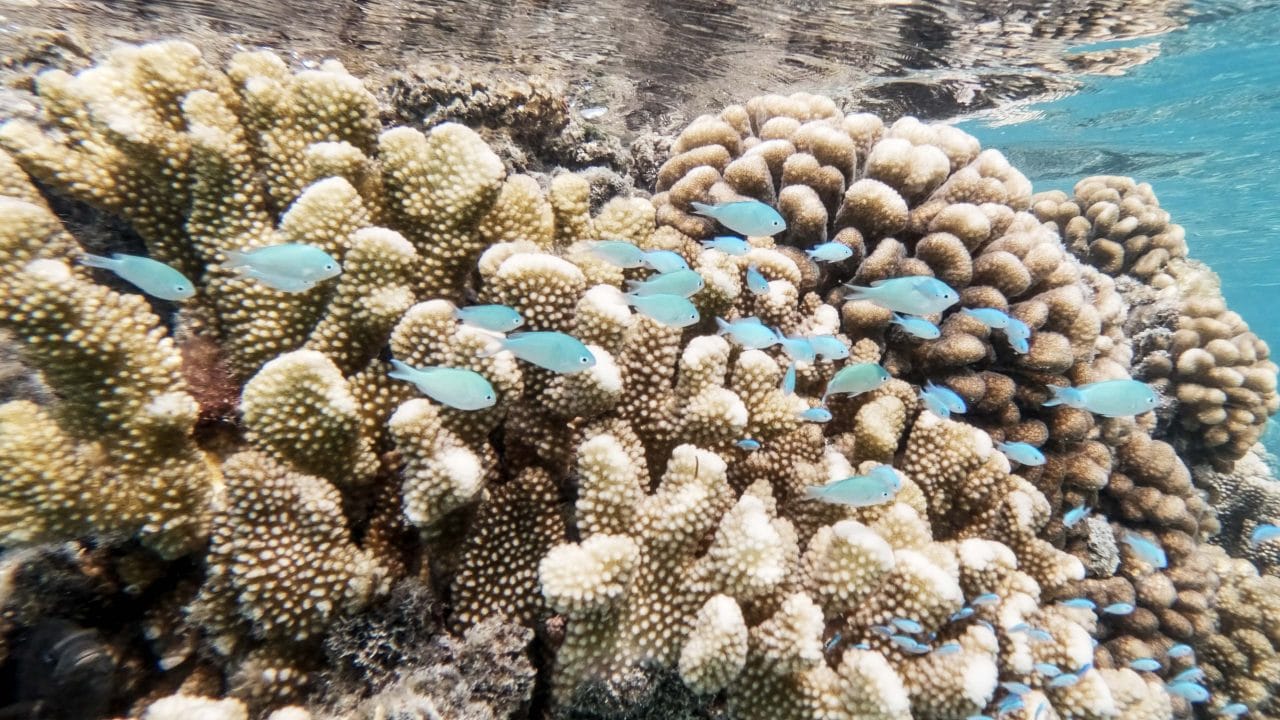The incredible story of a Hollywood legend, a trailblazing conservation vision and the quest to catalog every species in a remote Polynesian paradise.
Rising gently from the crystalline blue waters, a breathtaking atoll appears, nearly invisible among the waves. Guided only by the sun, stars, birds and wave patterns, skilled Indigenous navigators once ferried royalty through these same waters to a hidden paradise: a group of 12 small motus (islets) 30 miles (50 kilo- meters) from Tahiti, seemingly afloat in the vast expanse of surrounding sea. Known as Tetiaroa, meaning ‘the one who stands apart’ in Tahitian, this atoll was more than a retreat for Polynesian nobility. It was a wild sanctuary: a haven where sea turtles nested, sea- birds thrived and giant coconut crabs roamed freely.
“The lagoon was… infused with more shades of blue than I thought possible”
Today, Tetiaroa is home to scientists, conservationists and the occasional A-list guest at its eco-resort. Yet, the story of how it became a beacon of sustainability and ecological research is one of vision, perseverance and an unlikely protagonist: Hollywood legend Marlon Brando.
Green instead of glitz
Brando first set foot on Tetiaroa in 1961 while filming Mutiny on the Bounty, and it captivated him immediately. “The lagoon was […] infused with more shades of blue than I thought possible: turquoise, deep blue, light blue, indigo blue, cobalt blue, royal blue, robin’s egg blue, aquamarine,” Brando wrote in his autobiography, Songs My Mother Taught Me.

It soon became his new home. He purchased it after marrying his Tahitian co-star Tarita Teriipaia and lived there for several years in a thatched hut with their two children. However, his dream extended beyond a private escape – he envisioned Tetiaroa as a prototype for a new kind of conservation. “It is my hope that the island will serve as an ecological model,” he said, “not only a tourist preserve but a marine preserve as well – a place for all manner of scientific research and investigation.” Bringing this vision to life would take decades.
Like many natural wonders, Tetiaroa suffered ecological decline following European contact in the 1760s. Invasive species – including rats, mosquitoes and non-native coconut palms – disrupted its delicate balance, threatening native flora and fauna. The atoll, once a pristine refuge, struggled under the weight of human impact.
“Brando’s ideas about creating an ecostation alongside a resort were well ahead of their time”
Richard Bailey, founder of The Brando
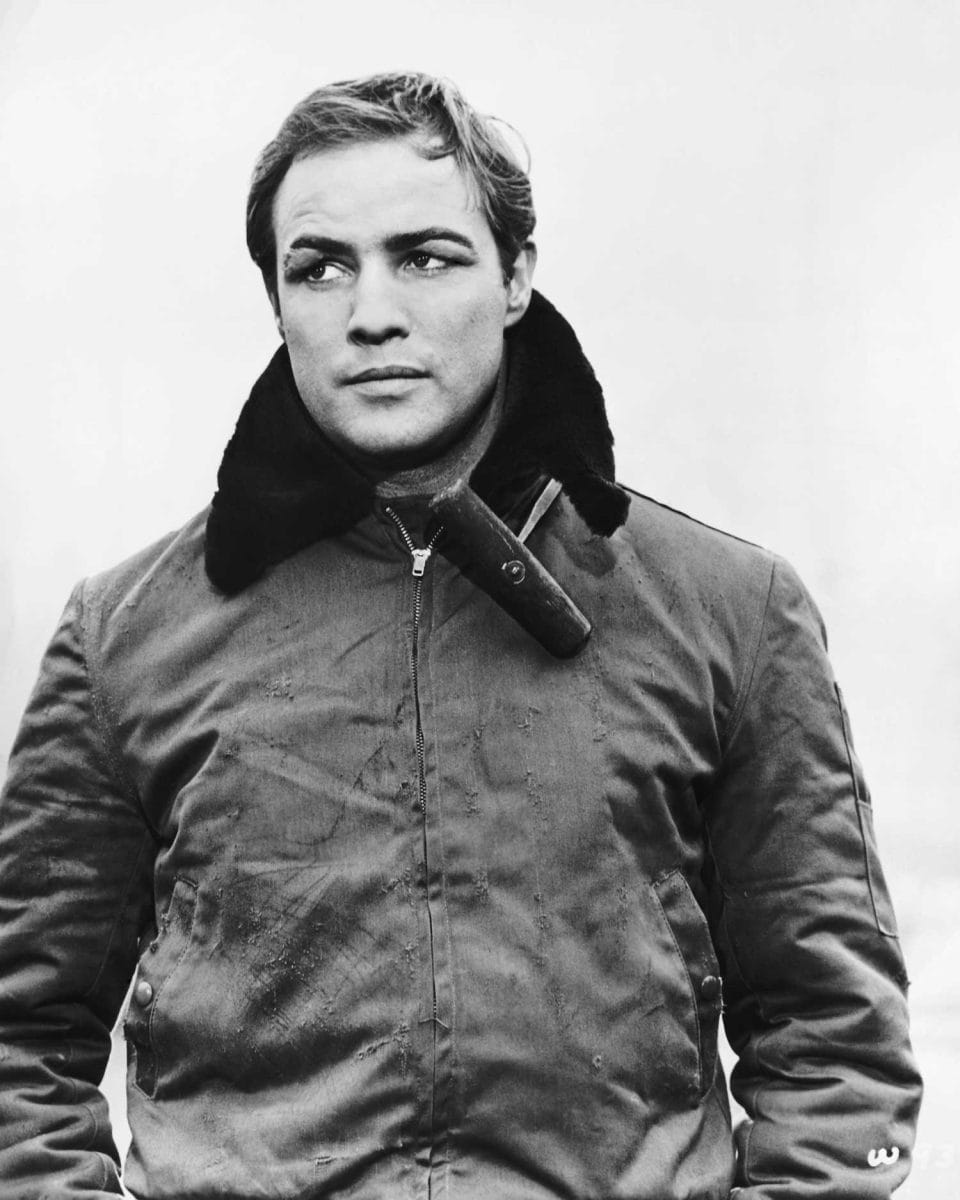
Then, in 1999, Brando found a partner willing to take on the challenge of opening the atoll to guests while restoring and preserving it: Richard Bailey, a seasoned hospitality developer who, like Brando, had fallen in love with French Polynesia, married local and went on to raise his family there. Over five years, the two engaged in deep discussions, exploring ways to harmonize sustainable development with conservation and cultural preservation.
Bailey found himself wondering whether Brando was even more passionate about conservation than he was about his career. “Marlon was an interesting man,” Bailey recalls. “He didn’t place much value on the many masks he wore as an actor, but he was deeply fascinated by science and conservation. His ideas about creating an ecostation alongside a resort were well ahead of their time. I learned a lot from our debates.”
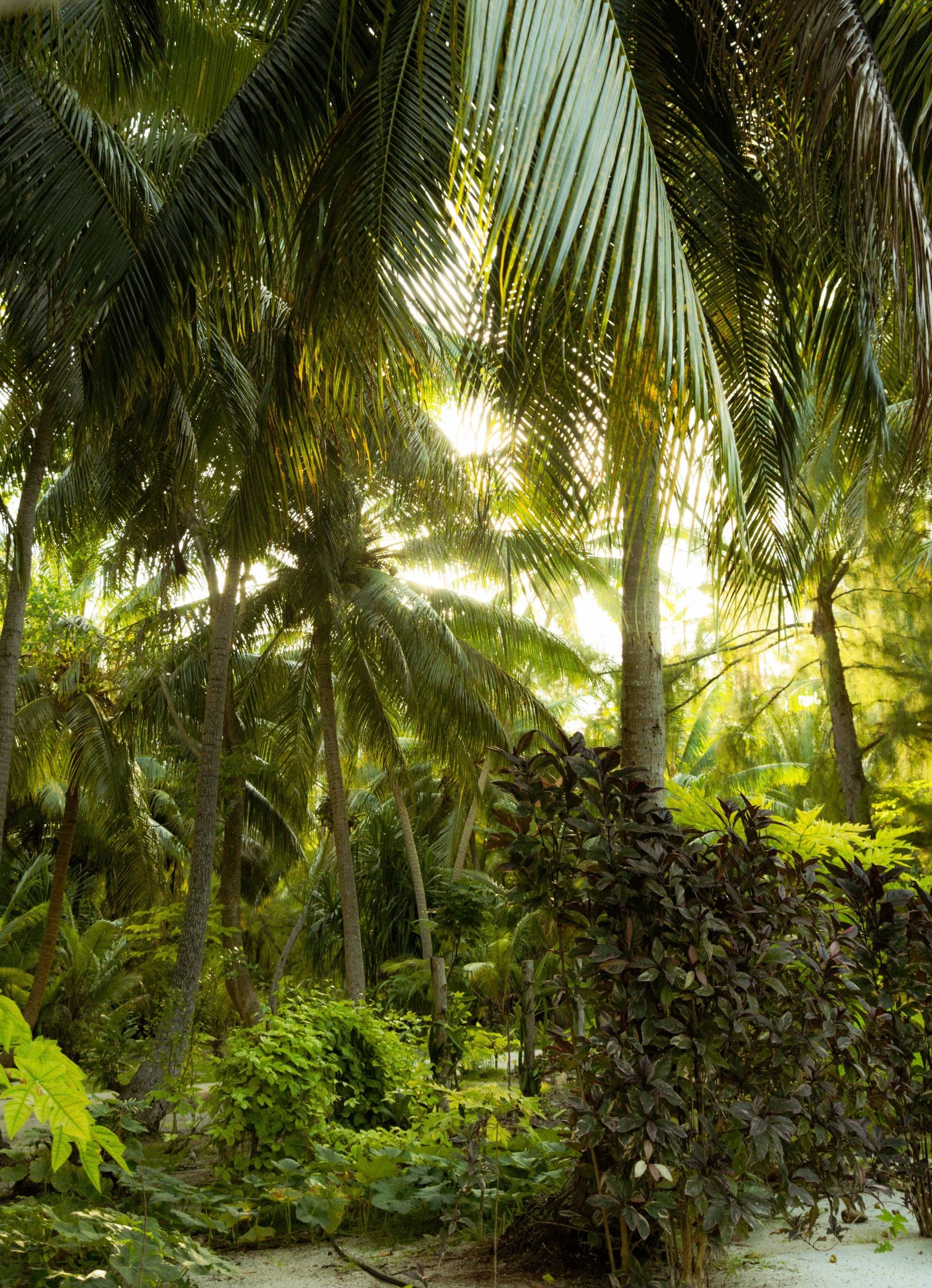
Tetiaroa is renowned for its rich biodiversity, also making it an ideal research hub. Photo: The Brando Resort
Following Brando’s death in 2004, Bailey and his team forged ahead, working to realize the actor’s dream and leasing the atoll’s islands from the trust Brando had set up for his heirs. Their approach was meticulous – removing decades of accumulated waste, restoring natural habitats, and designing a sustainable development that would blend in, hidden from the coastline, nestled among the mangroves.
A decade later, in 2014, the Tetiaroa Ecostation and The Brando resort finally opened their doors, setting a new standard for conservation-driven tourism, moving beyond the idea of merely reducing harm, to support regeneration.
A bridge between science and culture
At the heart of it all is the Ecostation, supporting research and education on topics many island nations are grappling with, such as ocean acidification, atoll erosion, coral reef ecology, plus marine bird and green sea turtle conservation.

Green sea turtles come to the atoll to nest. Photo: Odieux Boby

Protecting these endangered species is a core activity at the Ecostation. Photo: The Brando Resort
The atoll is one of three major nesting sites in the region for these endangered turtles, and the Ecostation is working with local NGOs Te Mana o Te Moana and Te Manu to monitor and protect vital breeding populations. Nightly, volunteers monitor the activities of nesting sea turtles and lucky guests can also enjoy the spectacle. “To witness an early morning race to the sea with hundreds of baby hatchlings is simply miraculous and awe-inspiring,” one visitor commented.
A major project is underway to catalog every species of flora and fauna on the atoll, in collaboration with a nearby research station run by the University of California Berkeley. They are embedding traditional knowledge into the study through ‘ethno-codes’, which document the cultural significance and role of each species in the ecosystem. Every research initiative includes a cultural advisor, fully integrating modern conservation efforts with respect for Indigenous perspectives.

But it’s not just about preserving every species. It’s also about restoring the atoll’s natural ecology. Take the invasive mosquitoes that threaten native wildlife. A groundbreaking initiative led by entomologist Hervé Boisson at Tahiti’s Malardé Institute for medical research, successfully eliminated non-native mosquitoes by releasing sterilized males – a first for any atoll. “Our pioneering work here has become a model for others around the world,” says Boisson. By halting the spread of mosquito-borne pathogens, the program has helped restore seabird populations and reduced the spread of human diseases, demonstrating how small-scale innovations here can have far-reaching global impact.
Reviving ancient conservation practices
The Ecostation also serves as an education hub, training local rangers and guides who come to the atoll to learn before going on to teach students in the wider region – from elementary school to university – about biodiversity, ocean ecosystems and the deep connection between Indigenous culture and environ- mental stewardship.
Exemplifying this connection is Rāhui, a traditional conservation system developed long before mod- ern environmental policies. Found across Polynesia – from Hawaii to Aotearoa (New Zealand) – this ancient practice designates certain areas as temporarily off-limits (tapu) to allow ecosystems to regenerate. This is where the English word ‘taboo’ is believed to have originated, first appearing in the writing of Captain James Cook after a visit to Tonga.

The resort makes use of fresh local produce, like these figs. Photo: The Brando Resort

Honey harvesting on the atoll. Photo: The Brando Resort
Once the Rāhui is ceremoniously lifted, the community can responsibly access marine and plant resources once again. Today, this Indigenous practice remains overwhelmingly favored by Polynesians over externally imposed conservation policies and its effectiveness continues to be demonstrated.
Atoll stewardship and the future of Tetiaroa
Frank Murphy, program director of the Tetiaroa Society, is proud of this tiny atoll’s role in the bigger picture. “We have an unparalleled opportunity to support local and international education, research and groundbreaking knowledge creation. We believe in the strength of continually combining scientific inquiry with respect for the Indigenous culture, enabling us to both advance into the future while drawing deeply from the wisdom of the past,” he says.
The Tetiaroa Society is responsible for the long-term environmental stewardship of the atoll and was established as a collaborative non-profit venture between the Marlon Brando Estate and The Brando resort. Its board includes local leaders and scientists, as well as one of Brando’s grandsons, to ensure that both cultural heritage and scientific expertise shape the atoll’s future. The society strictly limits developments across Tetiaroa to only the two motus where the resort and Ecostation are located, leaving the rest of the atoll in its untouched, pristine state.
So what about the resort itself? Staying true to Brando’s original vision, the resort is designed to operate with the lowest possible environmental impact. Solar power, supported by an advanced battery storage system, provides the island’s primary energy source, while a closed-loop recycling and composting system ensures that no waste is left behind. All transportation on the island is electric or human-powered, relying on bicycles and golf carts to minimize emissions. Water conservation involves a sophisticated system for capturing and recycling scarce freshwater.
One of the atoll’s most innovative sustainability initiatives is its use of sea water air conditioning (SWAC) – a cutting-edge technology that naturally cools buildings with seawater. First pioneered in Hawaii, this system was introduced to French Polynesia by Bailey and implemented at a resort in Moorea before being fully developed at The Brando. The technology’s success on Tetiaroa has since inspired its adoption in Tahiti’s main hospital, highlighting its potential for broader applications in sustainable development.

For visitors, the commitment to conservation is not just something to observe – it’s an experience. Guests are invited to take a Green Tour, where knowledgeable guides showcase the atoll’s groundbreaking sustainability efforts. From solar-powered energy systems to wildlife conservation programs, the tour offers a rare glimpse into the delicate balance between tourism and environmental responsibility. Through this model, Tetiaroa not only protects its own eco- system but also serves as an inspiring example of how sustainable tourism and conservation can thrive hand in hand.
A model for sustainable development
“Tetiaroa stands as a shining example in the islands of what is possible when a community actively engages in the conservation of its natural and cultural heritage alongside sustainable tourism,” says Hinano Murphy, Tetiaroa Society board member and founder of Te Pu Atitia, an organization committed to protecting Polynesia’s biocultural abundance.
So much more than a picture-perfect paradise, Tetiaroa today is a call to knowledge and regeneration. To holding on and shaping anew. It’s what can happen when you take it slow, team up and dare to dream.

Cover star Madame Gandhi on the sounds of the Antarctic, free climber Alex Honnold reveals his biggest challenge yet, actor Rainn Wilson embraces his soulful side and much much more!
Greener travel
